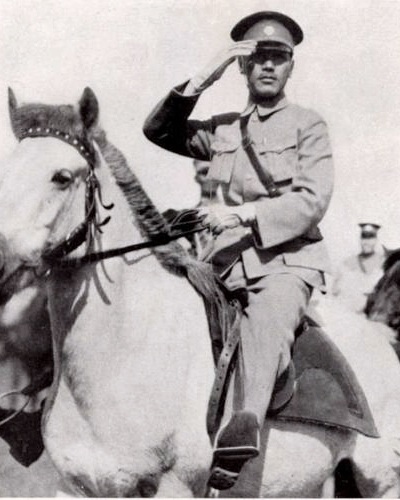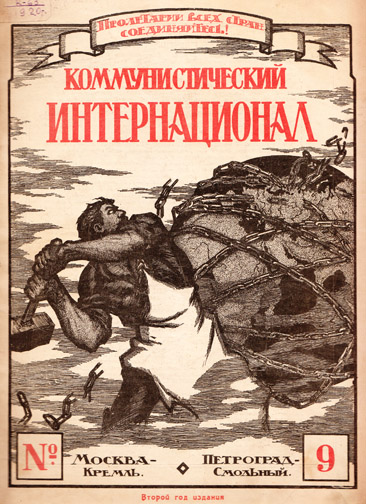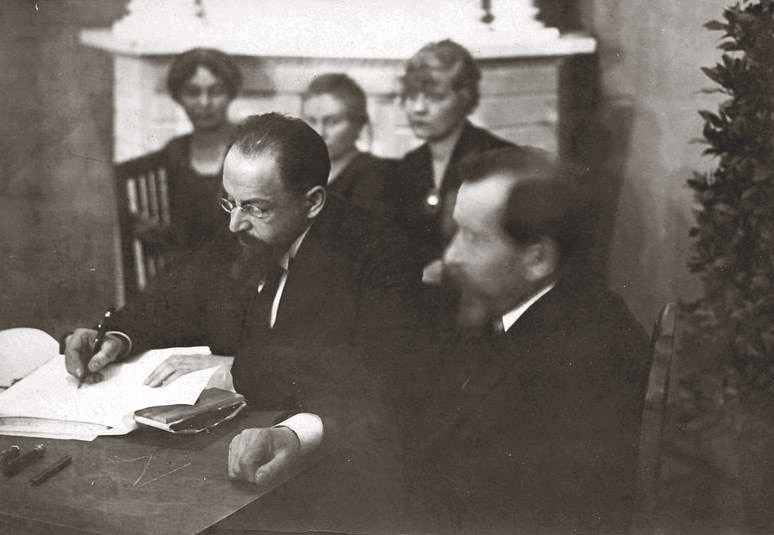|
12 April Incident
The Shanghai massacre of 12 April 1927, the April 12 Purge or the April 12 Incident as it is commonly known in China, was the violent suppression of Chinese Communist Party (CCP) organizations and leftist elements in Shanghai by forces supporting General Chiang Kai-shek and conservative factions in the Kuomintang (Chinese Nationalist Party or KMT). Following the incident, conservative KMT elements carried out a full-scale purge of Communists in all areas under their control, and violent suppression occurred in Guangzhou and Changsha. The purge led to an open split between left-wing and right-wing factions in the KMT, with Chiang Kai-shek establishing himself as the leader of the right-wing faction based in Nanjing, in opposition to the original left-wing KMT government based in Wuhan, which was led by Wang Jingwei. By 15 July 1927, the Wuhan regime had expelled the Communists in its ranks, effectively ending the First United Front, a working alliance of both the KMT and CCP under ... [...More Info...] [...Related Items...] OR: [Wikipedia] [Google] [Baidu] |
Shanghai
Shanghai (; , , Standard Mandarin pronunciation: ) is one of the four direct-administered municipalities of the People's Republic of China (PRC). The city is located on the southern estuary of the Yangtze River, with the Huangpu River flowing through it. With a population of 24.89 million as of 2021, Shanghai is the most populous urban area in China with 39,300,000 inhabitants living in the Shanghai metropolitan area, the second most populous city proper in the world (after Chongqing) and the only city in East Asia with a GDP greater than its corresponding capital. Shanghai ranks second among the administrative divisions of Mainland China in human development index (after Beijing). As of 2018, the Greater Shanghai metropolitan area was estimated to produce a gross metropolitan product (nominal) of nearly 9.1 trillion RMB ($1.33 trillion), exceeding that of Mexico with GDP of $1.22 trillion, the 15th largest in the world. Shanghai is one of the world's major centers for ... [...More Info...] [...Related Items...] OR: [Wikipedia] [Google] [Baidu] |
Communist International
The Communist International (Comintern), also known as the Third International, was a Soviet-controlled international organization founded in 1919 that advocated world communism. The Comintern resolved at its Second Congress to "struggle by all available means, including armed force, for the overthrow of the international bourgeoisie and the creation of an international Soviet republic as a transition stage to the complete abolition of the state". The Comintern was preceded by the 1916 dissolution of the Second International. The Comintern held seven World Congresses in Moscow between 1919 and 1935. During that period, it also conducted thirteen Enlarged Plenums of its governing Executive Committee, which had much the same function as the somewhat larger and more grandiose Congresses. Joseph Stalin, leader of the Soviet Union, dissolved the Comintern in 1943 to avoid antagonizing his allies in the later years of World War II, the United States and the United Kingdom. It was ... [...More Info...] [...Related Items...] OR: [Wikipedia] [Google] [Baidu] |
Jiangxi
Jiangxi (; ; formerly romanized as Kiangsi or Chianghsi) is a landlocked province in the east of the People's Republic of China. Its major cities include Nanchang and Jiujiang. Spanning from the banks of the Yangtze river in the north into hillier areas in the south and east, it shares a border with Anhui to the north, Zhejiang to the northeast, Fujian to the east, Guangdong to the south, Hunan to the west, and Hubei to the northwest. The name "Jiangxi" is derived from the circuit administrated under the Tang dynasty in 733, Jiangnanxidao (; Gan: Kongnomsitau). The abbreviation for Jiangxi is "" (; Gan: Gōm), for the Gan River which runs across from the south to the north and flows into the Yangtze River. Jiangxi is also alternately called ''Ganpo Dadi'' () which literally means the "Great Land of Gan and Po". After the fall of the Qing dynasty, Jiangxi became one of the earliest bases for the Communists and many peasants were recruited to join the growing people's ... [...More Info...] [...Related Items...] OR: [Wikipedia] [Google] [Baidu] |
Hubei
Hubei (; ; alternately Hupeh) is a landlocked province of the People's Republic of China, and is part of the Central China region. The name of the province means "north of the lake", referring to its position north of Dongting Lake. The provincial capital, Wuhan, serves as a major transportation hub and the political, cultural, and economic hub of central China. Hubei's name is officially abbreviated to "" (), an ancient name associated with the eastern part of the province since the State of E of the Western Zhou dynasty of –771 BCE; a popular name for Hubei is "" () (suggested by that of the powerful State of Chu, which existed in the area during the Eastern Zhou dynasty of 770 – 256 BCE). Hubei borders the provinces of Henan to the north, Anhui to the east, Jiangxi to the southeast, Hunan to the south, Chongqing to the west, and Shaanxi to the northwest. The high-profile Three Gorges Dam is located at Yichang, in the west of the province. Hubei is the 7th-largest p ... [...More Info...] [...Related Items...] OR: [Wikipedia] [Google] [Baidu] |
Hunan
Hunan (, ; ) is a landlocked province of the People's Republic of China, part of the South Central China region. Located in the middle reaches of the Yangtze watershed, it borders the province-level divisions of Hubei to the north, Jiangxi to the east, Guangdong and Guangxi to the south, Guizhou to the west and Chongqing to the northwest. Its capital and largest city is Changsha, which also abuts the Xiang River. Hengyang, Zhuzhou, and Yueyang are among its most populous urban cities. With a population of just over 66 million residing in an area of approximately , it is China's 7th most populous province, the fourth most populous among landlocked provinces, the second most populous in South Central China after Guangdong and the most populous province in Central China. It is the largest province in South-Central China and the fourth largest among landlocked provinces and the 10th most extensive province by area. Hunan's nominal GDP was US$ 724 billion (CNY 4.6 trillion) a ... [...More Info...] [...Related Items...] OR: [Wikipedia] [Google] [Baidu] |
Guangdong
Guangdong (, ), alternatively romanized as Canton or Kwangtung, is a coastal province in South China on the north shore of the South China Sea. The capital of the province is Guangzhou. With a population of 126.01 million (as of 2020) across a total area of about , Guangdong is the most populous province of China and the 15th-largest by area as well as the second-most populous country subdivision in the world (after Uttar Pradesh in India). Its economy is larger than that of any other province in the nation and the fifth largest sub-national economy in the world with a GDP (nominal) of 1.95 trillion USD (12.4 trillion CNY) in 2021. The Pearl River Delta Economic Zone, a Chinese megalopolis, is a core for high technology, manufacturing and foreign trade. Located in this zone are two of the four top Chinese cities and the top two Chinese prefecture-level cities by GDP; Guangzhou, the capital of the province, and Shenzhen, the first special economic zone in the count ... [...More Info...] [...Related Items...] OR: [Wikipedia] [Google] [Baidu] |
National Revolutionary Army
The National Revolutionary Army (NRA; ), sometimes shortened to Revolutionary Army () before 1928, and as National Army () after 1928, was the military arm of the Kuomintang (KMT, or the Chinese Nationalist Party) from 1925 until 1947 in China. It also became the regular army of the Republican era during the KMT's period of party rule beginning in 1928. It was renamed the Republic of China Armed Forces after the 1947 Constitution, which instituted civilian control of the military. Originally organized with Soviet aid as a means for the KMT to unify China during the Warlord Era, the National Revolutionary Army fought major engagements in the Northern Expedition against the Chinese Beiyang Army warlords, in the Second Sino-Japanese War (1937–1945) against the Imperial Japanese Army and in the Chinese Civil War against the People's Liberation Army. During the Second Sino-Japanese War, the armed forces of the Chinese Communist Party were nominally incorporated into the Nation ... [...More Info...] [...Related Items...] OR: [Wikipedia] [Google] [Baidu] |
Canton Coup
The Canton Coup of 20 March 1926, also known as the or the was a purge of Communist elements of the Nationalist army in Guangzhou (then romanized as "Canton") undertaken by Chiang Kai-shek. The incident solidified Chiang's power immediately before the successful Northern Expedition, turning him into the paramount leader of the country. History Background At the time of the incident, the Nationalist and Communist parties of China were working together as part of the First United Front, allied against the local warlords who were carving the country into fiefdoms. The Soviet Union was working with both groups and notably bankrolling Guangzhou's Whampoa Military Academy. It had assisted Sun Yat-sen in regaining control of Guangdong; after his death from cancer in 1925, the Nationalists began a protracted leadership struggle that included interprovincial war. The assassination of Liao Zhongkai led to Hu Hanmin's ouster and the promotion of Chiang Kai-shek, then commandant of ... [...More Info...] [...Related Items...] OR: [Wikipedia] [Google] [Baidu] |
Peking
} Beijing ( ; ; ), alternatively romanized as Peking ( ), is the capital of the People's Republic of China. It is the center of power and development of the country. Beijing is the world's most populous national capital city, with over 21 million residents. It has an administrative area of , the third in the country after Guangzhou and Shanghai. It is located in Northern China, and is governed as a municipality under the direct administration of the State Council with 16 urban, suburban, and rural districts.Figures based on 2006 statistics published in 2007 National Statistical Yearbook of China and available online at archive. Retrieved 21 April 2009. Beijing is mostly surrounded by Hebei Province with the exception of neighboring Tianjin to the southeast; together, the three divisions form the Jingjinji megalopolis and the national capital region of China. Beijing is a global city and one of the world's leading centres for culture, diplomacy, politics, finance, bu ... [...More Info...] [...Related Items...] OR: [Wikipedia] [Google] [Baidu] |
Northern Expedition
The Northern Expedition was a military campaign launched by the National Revolutionary Army (NRA) of the Kuomintang (KMT), also known as the "Chinese Nationalist Party", against the Beiyang government and other regional warlords in 1926. The purpose of the campaign was to reunify China, which had become fragmented in the aftermath of the Revolution of 1911. The expedition was led by Generalissimo Chiang Kai-shek, and was divided into two phases. The first phase ended in a 1927 political split between two factions of the KMT: the right-leaning Nanjing faction, led by Chiang, and the left-leaning faction in Wuhan, led by Wang Jingwei. The split was partially motivated by Chiang's Shanghai Massacre of Communists within the KMT, which marked the end of the First United Front. In an effort to mend this schism, Chiang Kai-shek stepped down as the commander of the NRA in August 1927, and went into exile in Japan. The second phase of the Expedition began in January 1928, when Chiang ... [...More Info...] [...Related Items...] OR: [Wikipedia] [Google] [Baidu] |
Mikhail Borodin
Mikhail Markovich Gruzenberg, known by the alias Borodin, zh, 鮑羅廷 (9 July 1884 – 29 May 1951), was a Bolshevik revolutionary and Communist International (Comintern) agent. He was an advisor to Sun Yat-sen and the Kuomintang (KMT) in China during the 1920s. Born in a rural part of the Russian Empire (now Belarus), to a Jewish family, Borodin joined the General Jewish Labour Bund at age sixteen, and then the Bolsheviks in 1903. After being arrested for participating in revolutionary activities, Borodin fled to America, attended Valparaiso University, started a family, and later established an English school for Russian Jewish immigrants in Chicago. Upon the success of the October Revolution in 1917, Borodin returned to Russia, and served in various capacities in the new Soviet government. From 1919, he served as an agent of the Comintern, travelling to various countries to spread the Bolshevik revolutionary cause. In 1921, Borodin arrived in Turkey to help the Turkish ... [...More Info...] [...Related Items...] OR: [Wikipedia] [Google] [Baidu] |
Adolph Joffe
Adolph Abramovich Joffe (russian: Адо́льф Абра́мович Ио́ффе, alternative transliterations Adol'f Ioffe or, rarely, Yoffe) (10 October 1883 in Simferopol – 16 November 1927 in Moscow) was a Russian revolutionary, a Bolshevik politician and a Soviet diplomat of Karaite descent. Biography Revolutionary career Adolf Abramovich Joffe was born in Simferopol, Crimea, Russian Empire in a wealthy Karaite family.See Albert S. Lindemann. ''Esau's Tears: Modern Anti-Semitism and the Rise of the Jews'', Cambridge University Press, 1997; pg. 430. He became a social democrat in 1900 while still in high school, formally joining the Russian Social Democratic Labor Party in 1903. In 1904 Joffe was sent to Baku, which he had to flee to avoid arrest. He was then sent to Moscow, but had to flee again, this time abroad. After the events of Bloody Sunday on 9 January 1905, Joffe returned to Russia and took an active part in the Russian Revolution of 1905. In early 1906 ... [...More Info...] [...Related Items...] OR: [Wikipedia] [Google] [Baidu] |



.jpg)




